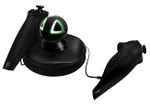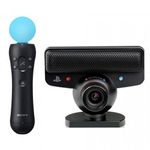Difference between revisions of "CSE165W2015"
(→Announcements) |
(→Grading) |
||
| Line 96: | Line 96: | ||
| 10% | | 10% | ||
|- | |- | ||
| − | | | + | | Pop Quizzes |
| 5% | | 5% | ||
|} | |} | ||
Revision as of 12:10, 5 February 2015
Contents |
CSE165: 3D User Interaction
Description
|
This course focuses on the design and evaluation of three-dimensional (3D) user interfaces, devices, and interaction techniques. The course consists primarily of lectures and hands-on programming. Students will be expected to implement several 3D interaction techniques as part of this course. The course is intended to lay the foundation for 3D user interaction as it can be applied to novel user interfaces for computer games and consumer electronics, as well as virtual and augmented reality applications. An important aspect of the course are going to be programming assignments involving 3D interaction devices, which are going to be provided to the students for the duration of the projects. These devices will include the Microsoft Kinect, the Razer Hydra, the Leap, the zSpace, and most likely the Sony Move. We will use the C++ programming language and OpenGL, along with the Bullet library for physics simulation.
Course ScheduleClick here for the course schedule. It lists lecture dates, homework due dates, and recommended reading. Announcements
Topics
Prerequisites
Format
Grading
You will find your scores on Ted. Please verify a few days after after every due date that your score has been recorded correctly and inform your grader if it has not. If your weighted average score across all assignments is 100 points or more, you will get a grade of A+. Final ProjectThere will not be a final exam, but the last programming project will be presented to the entire class during our final exam slot on Thursday, March 19th between 3 and 6pm. TextbookThe textbook is recommended, but not mandatory as the lecture slides will be made available after each lecture and there will not be reading assignments.
Homework AssignmentsAll homework assignments are due at 1:00pm on the due date and have to be demonstrated to the instructor, TA or tutor in one of the CSE labs during grading time (Fridays 1pm-2:50pm). If someone absolutely cannot present on the due date, they need to arrange for early grading with the TA or tutor by email.
Resources |





